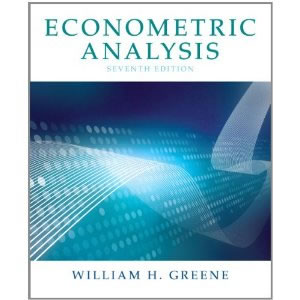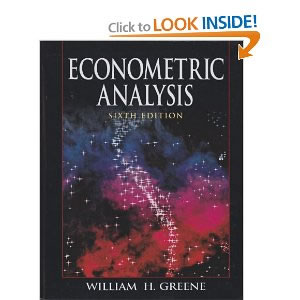Temple University
Department of Economics
Economics 8009
Econometrics I
Fall 2011
5:30 PM - 8:00 PM
Anderson 2
Required: The following is
required. There will be no exceptions!
 Econometric Analysis, 6th Ed., William H. Greene, Prentice-Hall,
2008.
Econometric Analysis, 6th Ed., William H. Greene, Prentice-Hall,
2008. 
This book is the most widely used text in U.S. grad programs. It will
challenge you every step of the way, but it is well worth the investment in time and
money. There are only small changes from one edition to the next, so the 5th edition will suffice but the burden is on you to make the bridge from the earlier to the more recent edition. I now see that there is a 7th edition and that it costs $200; yikes. Find what you can on Amazon or the like.
Not Required but Recommended:
- MathCAD This is a computer algebra program in the WYSIWYG style. You
will find this to be very useful during your time as a grad student.
A free alternative, Maxima, is available at
http://maxima.sourceforge.net/index.shtml
and a user friendly interface can be obtained at
http://wxmaxima.sourceforge.net/index.html
These links were given to me by a student. I have not used this
software, so you are on your own.
2. Statistical Software
An
Introduction
to R
An R
Manual for Econometrics
STATA is
available on many CLA, Fox and Tech Center computers
EVIEWS is also widely available on campus, including the econ grad student tech room on the 8th floor of Ritter Annex.
I am a fan of both EVIEWS and LIMDEP. Both SAS and SPSS are
serviceable. The Choice of statistical software is yours.
Optional (If you can find a copy):
 Introductory Econometrics: A Modern Approach, Jeffrey Wooldridge, 4th Edition, Southwestern-Cengage Learning, 2009. This is an undergrad textbook, but is quite thorough and generally well written. It was the required text in my Econ 3503 in spring 2011 so you might be able to find a used copy on campus.
Introductory Econometrics: A Modern Approach, Jeffrey Wooldridge, 4th Edition, Southwestern-Cengage Learning, 2009. This is an undergrad textbook, but is quite thorough and generally well written. It was the required text in my Econ 3503 in spring 2011 so you might be able to find a used copy on campus.
An Introduction to Classical Econometric Theory, Paul Ruud, Oxford
University Press. What makes this introductory is that it covers the
published literature without presenting material that is not yet in print.
Presents a geometric interpretation of much of the algebraic representation of
estimation and statistics.
Intermediate Statistics and Econometrics: A Comparative Approach, Dale
Poirier, MIT Press. You should be able to work with most of the material in
this book. A good presentation of Bayesian statistics and its relation to
classical statistics.
Econometrics, Franco Peracchi, Wiley, 2001. This is
a very challenging textbook. From the very start it prepares you to be
reading on the frontiers of econometrics, applied and theoretical.
A Guide to Econometrics, Peter Kennedy, ?th edition, MIT Press.
A very good guide for the practitioner.
Basic Econometrics, 3rd Ed. or more recent, Damodar Gujarati, McGraw-Hill, 1995.
Gujarati's book is a nice undergraduate treatment of econometrics. It is short on
theory and has many numerical examples; as such it makes good background reading for
Greene.
Econometric Theory and Methods, Russell Davidson and James MacKinnon,
Oxford University Press. Very good presentations of frontier
econometrics.
Electronic Texts:
The syllabus has many links to the lecture notes which I have written over the years.
The lecture notes are meant to be read along with the text for the course. In addition I
have links to a set of lecture notes prepared by Douglas J. Miller (Ph.D., Berkeley,
1994), Assistant Professor of Economics, Iowa State University. His excellent lecture
notes are more advanced than my own.
There is an index
to other course notes available online. The files are predominantly
in *.pdf and so your computer is nothing more than an electronic page turner.
Links to some graphic
JAVA applets to aid your understanding.
 Econometric Analysis, 6th Ed., William H. Greene, Prentice-Hall,
2008.
Econometric Analysis, 6th Ed., William H. Greene, Prentice-Hall,
2008. 
 Introductory Econometrics: A Modern Approach, Jeffrey Wooldridge, 4th Edition, Southwestern-Cengage Learning, 2009. This is an undergrad textbook, but is quite thorough and generally well written. It was the required text in my Econ 3503 in spring 2011 so you might be able to find a used copy on campus.
Introductory Econometrics: A Modern Approach, Jeffrey Wooldridge, 4th Edition, Southwestern-Cengage Learning, 2009. This is an undergrad textbook, but is quite thorough and generally well written. It was the required text in my Econ 3503 in spring 2011 so you might be able to find a used copy on campus.